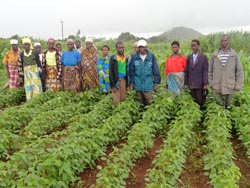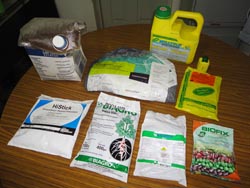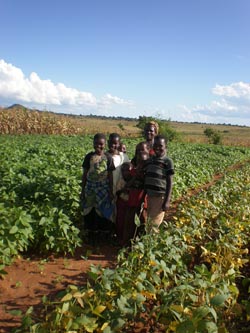Background
Mozambique is a large country with 10 major agro-ecological zones; from arid climate in Gaza province with less than 500 mm mean annual rainfall to tropical humid climate where mean annual rainfall is in excess of 1800 mm within parts of Zambezia, Lichinga, Nampula and Tete provinces. These high rainfall areas have the best potential for agriculture and are the regions where all kinds of crops grow well. Soyabean is among the crop with huge growth potential in the region and is becoming a major cash crop for smallholder farmers. Nationwide soyabean production in 2004 was estimated at 770-880 tons from an average yield of 450 kg/ha (Estrada, 2004*). Production increased 10-fold to 8000 tons in 2010 with an average productivity of 850 kg/ha (CLUSA, 2010*). Production in 2012 promoted by Soya value chain project being implemented by Technoserve alone is estimated at 31,000 tons from an average yield of 1100 tons/ha (Narciso Rodrigues, Technoserve, Pers. Comm.). Soyabean production is expected to increase over the coming years due to the high demand driven by the domestic poultry and livestock industries, available regional market and attractive prices. In 2006, the farm gate price for a kilogram of soyabean grain was 7-9 meticais (US$0.25-$0.33); however, the price averaged 19 meticais (US$0.68 in August 2012). The strong interest from foreign investors in the soyabean production sector in Mozambique recently, is another dynamic that likely will help put Mozambique on the map as a major soyabean producing country in the future.
Partnerships and major interventions
For many resource poor farmers, soyabean is a profitable smallholder crop that is easy to produce, does not take require much investment and improves soil health for the next crop. Thanks to the recent interventions by many collaborative projects implemented by both local and international organizations including IIAM, IITA, CLUSA, Technoserve and IKURU disseminated technology packages have been developed for smallholder farmers that have contributed to narrowing the yield gap: increasing yields from 450kg/ha to the current 1100kg/ha. Such yields are still well below soyabean yield potential in the region. The Platform Mozambique project funded by USAID and the Soya value chain project funded by the Bill & Melinda Gate Foundation and N2Africa are all helping smallholder farmers through diverse ways to make the soyabean story a great success. N2Africa focuses on N2-fixation technologies for enhancing legume yields and has partnered with other programs and Farmers’ Associations to develop, disseminate and promote appropriate N2-fixation technologies for smallholder farmers. The project is focusing on major soyabean production areas to reach more soyabean growers in order to maximize impact. In collaboration with farmers’ groups (e.g., Fig. 1), N2Africa has selected high-yielding soyabean varieties with high nitrogen fixing capacity and has made seeds of preferred soyabean varieties available to farmers associations and community-based organization for multiplication and distribution. N2Africa demonstrated the use of inoculants, P fertilizer and other inputs through on-farm demonstrations to create awareness and have disseminated inoculants and P fertilizer to many smallholder farmers for testing on their farms. The majority of the smallholder farmers had no or limited information on inoculants three or four years ago; however, many of these farmers are now willing to buy inoculants for their soyabean crop. In light of this, N2Africa in partnership with Technoserve facilitated the import of inoculants by a private company, AgriFocus Lda for sale to smallholder farmers during the 2011/12 growing season. Two additional companies imported inoculants for sale during the 2012/13 planting season. Fig. 2 is a collection of some of the inoculants imported and used in Mozambique during the 2012/13 growing season. These include MasterFix inoculant imported from Stoller do Brasil, Brazil; Biagro inoculant, Laboratorios Biagro, Argentina; Soycap, Soygro (Pty) Ltd, South Africa, Biomax Premium, Bio Soja Industrias Químicas e Biológicas Lda, Brazil; BioFix, MEA, Kenya; Cell Tech, Novozymes, Canada and HiStick, Becker Underwood, USA.
 |
 |
|
Fig. 1. Members of the Tirimbique Farmers’ Associations on a demo plot at a Tirimbique village in Angonia district, Tete province, Mozambique |
Fig.2. Some of the Rhizobial inoculants imported and used in Mozambique during the 2012/13 growing season |
Personal encounter
For Joia Alberto Muchengete (Fig. 3), the timing for the intervention could not be better. He is one of the farmers in Gurue district who benefited from demonstration plots established on farmers’ fields; the farmers prepared the land, participated in planting and also managed the day-day maintenance of the plots. He says he started producing soyabean in 2006 but it was not profitable at that time since yields were low and the price was not attractive; hence he produced tobacco and switched to soyabean the following season whenever tobacco price fell. Joia says soyabean production is now profitable because yields are higher now due to technologies made available to them by N2Africa and other projects and on top of this the farm gate price is very good for farmers compared with the prices for other competing crops like tobacco. Hence, he has been planting soyabean in the last 3 years. He planted 4 ha of soyabean last year and 7 ha this year.
 |
 |
|
Fig. 3. Joia Alberto Muchengete in his soyabean field at Ruace, Gurue district in Zambezia province, Mozambique |
Fig 4. Bibiana Bernardo Lead farmer and her children on her soybean demonstration plot at Ndundu in Angonia district, Tete province in Mozambique. Photo taken by Anne Turner |
Similarly, Bibiana Bernardo (Fig. 4) is a Lead farmer and has soyabean variety demonstration plots on her farm at Ndundu, a village in Angonia district, Tete province. She has 3.5 ha soyabean farm and expects to make more money this year than she made last year when she planted the field to maize. She says that the price of soyabean was high last season so those who grew soyabean made money. She is motivated by the fact that she would be able to identify the best yielding variety on her land and use the knowledge and skills she gained from the training to increase yield and income from the farm.
Prospects
We expect the interventions to continue to boost soyabean productivity and expand production to encourage full participation of the private sector at all levels along the value chain. It is anticipated that more agro-dealers will be involved in the supply and distribution of inputs to enhance accessibility by smallholder farmers even in remote areas. Home utilization of soyabean is gradually increasing following training and demonstration campaigns to improve nutritional quality of traditional carbohydrate foods and to encourage womens’ participation in project activities. The upward trend in home consumption of soyabean is stimulating intercropping soyabean with other food crops and it is anticipated that soyabean would be part of household diet in the near future.
The acquisition of large stretches of farm land by foreign investors is driving out smallholder farmers from their farmlands and this is likely to cause major conflicts if the acquisition continues. The challenge is: to what extent should the government open up good agricultural land to investors without affecting the land usage rights of smallholder farmers? For now land is not scarce in Mozambique as long as the companies follow the rules and resettle farmers properly. If managed well it could be a win-win situation: the companies could procure excess inputs for sale to smallholder farmers, serve as source of employment for the local people and also the farmers could serve as out growers for the companies. It is hoped that farmers’ training, demonstration and other forms of awareness creation will accelerate adoption and sustain high productivity, increase smallholder income and improve nutrition security.
References:
*CLUSA. 2010. Produção de Soja – Volumes Produzidos. Relatório do Workshop "Desenvolvimento da Cadeia de Valor da SojaHotel Zambeze, Tete 15 de Fev de 2010.
*Estrada, J. M. 2004. Regional overview of the soybean markets: Challenges and opportunities for smallholder farmers in Southern Africa. Study commissioned by IITA. Steve Boahen
